| Pages:
1
..
23
24
25
26
27
..
40 |
watson.fawkes
International Hazard
    
Posts: 2793
Registered: 16-8-2008
Member Is Offline
Mood: No Mood
|
|
An induction coil is, at the end of the day, just a transformer, albeit one with special construction to handle the high EMF
produced. I'll assume you know which is the primary and which is the secondary. Put a ~10 V AC source on the secondary and measure the voltage on the
primary, which will be some number of millivolts. The voltage ratio you get will be the transformer ratio (assuming an unsaturated core).
You can estimate the voltage by the length of the largest free spark it will generate. The rule of thumb is that the breakdown voltage in air is about
a kV per mm. It depends on a number of other factors, such as electrode shape, humidity, etc., so it's not a precise measure, but it does give a
sanity check. What you've got looks like something in the 5 kV - 10 kV range.
|
|
|
Morgan
International Hazard
    
Posts: 1660
Registered: 28-12-2010
Member Is Offline
Mood: No Mood
|
|
To me his device looks very much like model # 79800. It has the same company name and similar screws in the same spot.
"40 to 50kv on the secondary output."
http://www.humboldt.edu/scimus/HSC.54-70/CatDesc/InducCoil_C...
I have a couple of new Model T buzz coils, one in black plastic and one in wood and if they don't have an internal safety default gap or if the gap on
the outside terminals is greater than the spark can jump, it will arc internally so you wouldn't want to do that. Also if you reverse the polarity on
your battery from time to time, the points will last longer. They may be simple but the Model T coils will run happily for many years.
|
|
|
Morgan
International Hazard
    
Posts: 1660
Registered: 28-12-2010
Member Is Offline
Mood: No Mood
|
|
This spark was produced using a Scott Paper towel wrapped around a 6 foot piece of gray PVC. Around the lower half of the paper towel a folded dish
cloth was rolled over the paper towel, otherwise as you slide the paper towel sleeve over the plastic your hand gets numerous tiny shocks. A few
pieces of clear tape keeps the paper towel from unwrapping.
For the leyden jar I used a polypropylene bottle with a little salt water and for the top electrode a stainless steel water bottle purchased for about
6 dollars. If your hand gets too close when charging the bottle, the spark sometimes decides to travel down the PVC then through the paper towel cloth
wrap into your hand, which is disconcerting but not too harmful. Perhaps by constructing the leyden jar without the typical outer wrap of foil, high
voltage is favored over current. Also if a foil was used the bottle would have to be even taller to prevent the 11 inch spark from arcing to the sides
and perhaps without foil there is an added advantage of less leakage. Below the bottle is a square foot of .125 thick teflon, some acrylic and pvc
sheets to keep the spark from sneaking up from the grounding plate.
The "top" rounded edge of the steel bottle starts to hiss when fully charged so a PVC flex tubing was placed over the top to prevent leakage but it
kept sliding down so it was bent and angled away from the opposite electrode made from a few ball bearings and pipe. When the leyden jar discharges, I
found it helpful to waft the air to disperse the noxious fumes produced by the spark. It's a fun project though and you learn little things along the
way. Below is where I happened upon the basic idea. Electricity should be treated with respect, be sure you are sailing in safe waters when you
experiment.
http://amasci.com/static/foster1.html
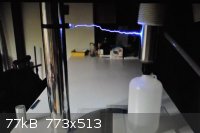 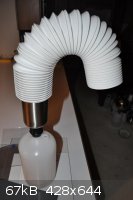
[Edited on 29-11-2012 by Morgan]
|
|
|
Mailinmypocket
International Hazard
    
Posts: 1351
Registered: 12-5-2011
Member Is Offline
Mood: No Mood
|
|
Thanks for that Watson- I will determine the voltages this weekend!
Really nice spark gap BTW Morgan! How long did it take to build that?
|
|
|
Morgan
International Hazard
    
Posts: 1660
Registered: 28-12-2010
Member Is Offline
Mood: No Mood
|
|
The 11 inch spark takes about 80 strokes but on the other end I've made 4 inch sparks in as little at 7 strokes using a smaller leyden jar. It's very
hard once you get past 10 inches, conditions have to be right, the air low humidity. I got a 14 inch spark almost but the rod dipped in the path and
stairstepped to the electrode when I triggered the spark. 13 inches is the longest so far. The base and sides of the plastic bottle as well as the
teflon sheet start crackling when charging, it's really quite impressive, like pulling apart clothes from a hot dryer. This is not always the case but
one time the teflon really came alive. Sometimes a false partial discharge occurs with a ~6 inch spark at the base of the bottle and the surface it's
resting on. High voltage crawls over the teflon square even though I try to keep it dust free.
There are many variables to ponder, like the type of PVC, the white, the CPVC which is chlorinated, and the gray. It would be nice to experiment with
teflon tubing. Then there's the diameter, or maybe a solid rod would work better but I doubt it. I tried putting a cap on one end and both ends,
putting metal inside the charging tube, different lengths and ways of rolling the paper towel, different cloths, different bases, electrode designs,
etc. I found if I had a fuzzy shirt on it seemed to weaken the charging and also if I took my shoes off the charging worked better. Anything within 3
feet of the leyden jar is going to be talking to it. I had to back my tripod up because it was bleeding the charge. It won't hold a 13 inch spark for
long if you stop charging either. I think a teflon bottle would be nice to if you wanted to make longer sparks still. The saline solution was a mix of
salt and Epsom salt but I was reading about other electrolytes. So there's lots of materials science fun here and I can't help but think you could
make something even more interesting perfecting this simple electrostatic device. Here's some odds tidbits and a pic of my leyden jar as the bottom
discharges resting on a copper slab. I couldn't capture the top spark in the frame when I paused the clip. These leyden jars and PVC charging rods
really don't take any time at all to make. The ball bearing electrode was a magnet for one of them and a baby nipple made of silicone to partially
separate them. It's interesting how this arrangement teases or excites the field. I know very little about it, but a quarter inch one was recommended
and I just decided to try three together instead of two. Any thoughts on any improvements or things to try would be welcome. These are not really
pretty pictures other than the simpleness factor.
http://www.altair.org/labnotes_hawgcap.html
http://books.google.com/books?id=cNUlQwAACAAJ&dq=magnesi...
"The chlorine content may vary from manufacturer to manufacturer; the base can be as low as PVC 56.7% to as high as 74% by mass, although most
commercial resins have chlorine content from 63% to 69%.[citation needed] As the chlorine content in CPVC is increased, its glass transition
temperature (Tg) increases significantly. Under normal operating conditions, CPVC becomes unstable at 70% mass of chlorine."
http://en.wikipedia.org/wiki/Chlorinated_polyvinyl_chloride
"The sparks at the bottom of the bottle are probably due to the high degree of ionization of the plastic surface and surrounding air opposite the salt
water."
http://amasci.com/static/foster1.html
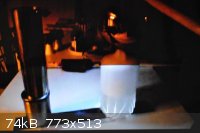
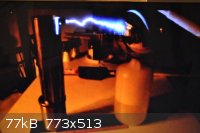
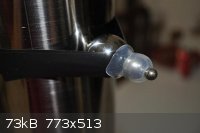
[Edited on 30-11-2012 by Morgan]
|
|
|
tetrahedron
Hazard to Others
  
Posts: 210
Registered: 28-9-2012
Member Is Offline
Mood: No Mood
|
|
nice electrostatic devices!
btw i used aluminum foil attached to the screen of a big crt tv to generate a high voltage charge safely and without too much work. do you have any
high voltage valves? if you have several such leyden jars you can charge them in parallel and discharge them in series for even longer sparks.
to minimize the discharge creeping along the insulator surface, it should be corrugated as done in industry:

|
|
|
Morgan
International Hazard
    
Posts: 1660
Registered: 28-12-2010
Member Is Offline
Mood: No Mood
|
|
I don't have any valves but my brother could probably build something for me. I want to keep it safe with high voltage and low amperage so that I can
accidentally shock myself without having to worry that I'm going to die. Those ceramic insulators would be fun to toy with.
I was reading this though about mica insulators which was kind of interesting. They make an electrical grade of teflon that has a very high dielectric
strength too, higher than mica according to this wiki article.
http://en.wikipedia.org/wiki/Dielectric_strength
"thin layers have higher dielectric strength (per unit thickness) than thick layers. A phenomenon that has surprised many. Ruby mica has such a high
dielectric strength partly because it is composed of many very uniform very thin layers stuck together."
http://www.altair.org/labnotes_hawgcap.html
"For electrostatics, the numbers are quite different. A Kelvin waterdrop generator might produce 20,000volts at 1/2 microamp. Dividing this voltage by
this current gives 40,000,000,000 ohms. That's the line between insulator and conductor. Quite different than three ohms! So, if an object is to act
as an insulator, its resistance must be MUCH greater than forty billion ohms! For a Kelvin generator, a ten-megohm piece of wood will act like a very
good conductor. Is it any wonder that a bit of surface moisture can convert an insulating object into a conductor? The highest value of resistor
commonly available in catalogs is 33 megohms, and most electrostatic devices will see this device not as a resistor, but as a dead short.
http://amasci.com/emotor/stathint.html
It's funny to me how the Lord Kelvin water dropper, Wimshurst Machine, Van de Graaff Generator, and Pelletron are so similar, little charges being
shuttled along and collected. In one variation Lord Kelvin uses copper filings instead of water droplets, which reminded me of a pelletron where
instead of air gaps it uses plastic chain between the metal pellets. I wonder how the PVC rod and paper tower sleeve friction charging method might be
diagrammed and how to improve on it? I took a 10 ft piece of ~3/4 inch CPVC pipe and bent it into a circle and thought about seeing how that would
work, spinning it somehow. I tried long flat strips of PVC instead of pipe and failed.
http://www.pelletron.com/charging.htm
http://jrm.phys.ksu.edu/Resource/Pics/Pelletron/24-CHAIN_LIN...
http://amasci.com/static/fostergen.html
Here's one of those 1 dollar aluminum water bottles you can by in different colors, this one green with tape over the bottom where some numbers or
letters were indented. I thought it might leak from those tiny edges so I taped it. The bottom bottle just HDPE, a quart bottle. Add salt and water,
that's it really. This one sparks relatively quickly with a modest gap of 4 inches or so. One time it only takes 7 to fire.
http://www.youtube.com/watch?v=SMJQmmyb7HI
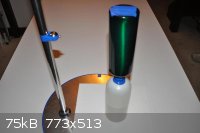
[Edited on 1-12-2012 by Morgan]
|
|
|
elementcollector1
International Hazard
    
Posts: 2684
Registered: 28-12-2011
Location: The Known Universe
Member Is Offline
Mood: Molten
|
|
<img src="http://25.media.tumblr.com/tumblr_mec1qkwaof1rlgzvyo1_1280.jpg" width="800" />
This is the tetra-amino copper complex (sorry if that's not quite the right name for it), made from copper metal and ammonium nitrate.
<!-- bfesser_edit_tag -->[<a href="u2u.php?action=send&username=bfesser">bfesser</a>: reduced
image width]
[Edited on 7/7/13 by bfesser]
Elements Collected:52/87
Latest Acquired: Cl
Next in Line: Nd
|
|
|
Morgan
International Hazard
    
Posts: 1660
Registered: 28-12-2010
Member Is Offline
Mood: No Mood
|
|
I should say you can make an even simpler leyden jar of sorts just using Coke cans. This is a full 12 ounce can with an empty 7.5 oz can taped on top.
They look the same size because of the angle. The lids are the same diameter though, I guess that helps in manufacturing. Maybe you could use a single
can or any blob of metal, the mystique reduced.
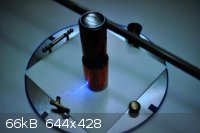
|
|
|
uzaymaymunu
Harmless

Posts: 34
Registered: 26-2-2012
Location: turkey
Member Is Offline
Mood: No Mood
|
|


My Chrome/Aluminium alum crystal. Is there any crystal growers? 
uzaymaymunu.blogspot.com
|
|
|
elementcollector1
International Hazard
    
Posts: 2684
Registered: 28-12-2011
Location: The Known Universe
Member Is Offline
Mood: Molten
|
|
I was going to get into crystal growing, but after I heard crystals like that take about 20 months to grow, I quickly scrapped any plans I had.
It looks absolutely beautiful, though. Don't you have to store these things moist to keep them translucent?
Elements Collected:52/87
Latest Acquired: Cl
Next in Line: Nd
|
|
|
uzaymaymunu
Harmless

Posts: 34
Registered: 26-2-2012
Location: turkey
Member Is Offline
Mood: No Mood
|
|
Quote: Originally posted by elementcollector1  | I was going to get into crystal growing, but after I heard crystals like that take about 20 months to grow, I quickly scrapped any plans I had.
It looks absolutely beautiful, though. Don't you have to store these things moist to keep them translucent? |
No it's beautiful hobby i think. And addictive. You should do. This crystal is 4 months old and 44 gram.
If your crystal solution stay hot area ( at about 30 celcius - maybe your room ) it grows faster.
And you can be faster in this method -->
http://www.youtube.com/watch?v=tG8KzOj-s4g
uzaymaymunu.blogspot.com
|
|
|
Wizzard
Hazard to Others
  
Posts: 337
Registered: 22-3-2010
Member Is Offline
Mood: No Mood
|
|
I grow crystals! That's a beauty, for sure. Next one you grow, top off the solution with potassium alum as it grows- Your crystal will have a dark
purple center, and fade to clear by the time it's ready to come out 
|
|
|
Morgan
International Hazard
    
Posts: 1660
Registered: 28-12-2010
Member Is Offline
Mood: No Mood
|
|
The long growing time of the crystals reminded me of a 2 liter bottle experiment. I wanted to know how long they would hold pressure as I was at the
time thinking of making a boat out of them. A device was made to pressurize the bottles and then twist the lid the rest of the way on tightly. There's
one bottle here that is still very hard, like a bicycle tire that hardly has any flex if you squeeze it, not as hard as a when you get a 2 liter from
the store but very close. The others have lost more air but I can stand on them and they still hold me up but now are springy. Affixed to one of the
bottles from my desk calendar was the date of inflation, Tuesday 17, March 1992! Some of the bottles were inflated with dry ice so I don't know if
these green ones had air or CO2 but another bottle with a tire valve stem in the cap inflated with air finally gave out earlier this year. Every few
years it was given the stand on it test. I put RTV on the sides of the bottles to hold them together and pieces of PVC to hold the necks together but
no RTV in the caps. I never would have thought they would hold pressure this long. Of course the caps would have leaked had any stress been put on
them.
Now they are making bottles in layers and maybe a bit thinner that the ones I used long ago.
http://www.ptonline.com/articles/barrier-pet-bottles
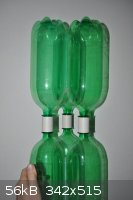
|
|
|
kristofvagyok
National Hazard
   
Posts: 659
Registered: 6-4-2012
Location: Europe
Member Is Offline
Mood: No Mood
|
|
Actually my fav picture was made not long ago:
 -click on the picture to visit my photoblog. -click on the picture to visit my photoblog.
In the funnel there is +600g of N-Nitroso-N-methylurea the direct precusor for diazomethane. How big explosion would have happen it it would be mixed
with a cc lye solution?
I have a blog where I post my pictures from my work: http://labphoto.tumblr.com/
-Pictures from chemistry, check it out(:
"You can’t become a chemist and expect to live forever." |
|
|
Hexavalent
International Hazard
    
Posts: 1564
Registered: 29-12-2011
Location: Wales, UK
Member Is Offline
Mood: Pericyclic
|
|
Is that you, kristof?
"Success is going from failure to failure without loss of enthusiasm." Winston Churchill
|
|
|
kristofvagyok
National Hazard
   
Posts: 659
Registered: 6-4-2012
Location: Europe
Member Is Offline
Mood: No Mood
|
|
Nope. If I would be on the picture than who would press the button on the camera?
I have a blog where I post my pictures from my work: http://labphoto.tumblr.com/
-Pictures from chemistry, check it out(:
"You can’t become a chemist and expect to live forever." |
|
|
Pyro
International Hazard
    
Posts: 1305
Registered: 6-4-2012
Location: Gent, Belgium
Member Is Offline
Mood: No Mood
|
|
Bromine clouds in my reaction flask
[Edited on 14-12-2012 by Pyro]
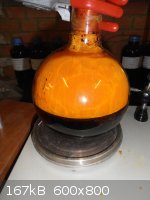
all above information is intellectual property of Pyro.  |
|
|
Endimion17
International Hazard
    
Posts: 1468
Registered: 17-7-2011
Location: shores of a solar sea
Member Is Offline
Mood: speeding through time at the rate of 1 second per second
|
|
kristofvagyok, that's a mighty funnel you've got there. 
Pyro, those are clouds of hydrogen bromide tinted with a bit of bromine. Bromine clouds are transparent and render the flask bloody red. U needz moar
oxuhdnts. 
|
|
|
Pyro
International Hazard
    
Posts: 1305
Registered: 6-4-2012
Location: Gent, Belgium
Member Is Offline
Mood: No Mood
|
|
meh, I used a stoich. amount. next time ill add a little excess. thanks
all above information is intellectual property of Pyro.  |
|
|
UnintentionalChaos
International Hazard
    
Posts: 1454
Registered: 9-12-2006
Location: Mars
Member Is Offline
Mood: Nucleophilic
|
|
If that was the prep I wrote up, a little HBr is normal in the beginning, but that should go away pretty quickly. I don't think there is a good fix
for this unless you can introduce H2SO4 under the surface of the stirred NaBr/KMnO4 solution/suspension and that is probably asking for clogging
issues.
Department of Redundancy Department - Now with paperwork!
'In organic synthesis, we call decomposition products "crap", however this is not a IUPAC approved nomenclature.' -Nicodem
|
|
|
kristofvagyok
National Hazard
   
Posts: 659
Registered: 6-4-2012
Location: Europe
Member Is Offline
Mood: No Mood
|
|
Here are some bromination pics from me:
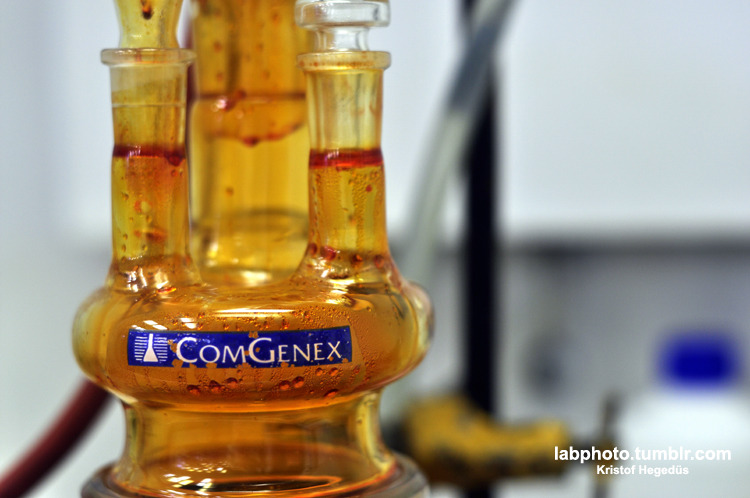
The pics were taken when almost all the bromine was reacted, just a little excess was still present. -It has an awesome color
Here is one from the beginning:

Here a massive amount was still in the gas space mixed with CHCl3 (the drops on the condenser).
[Edited on 15-12-2012 by kristofvagyok]
I have a blog where I post my pictures from my work: http://labphoto.tumblr.com/
-Pictures from chemistry, check it out(:
"You can’t become a chemist and expect to live forever." |
|
|
Eddygp
National Hazard
   
Posts: 858
Registered: 31-3-2012
Location: University of York, UK
Member Is Offline
Mood: Organometallic
|
|
Shouldn't this topic be sticky/pinned?
there may be bugs in gfind
[ˌɛdidʒiˈpiː] IPA pronunciation for my Username |
|
|
Pyro
International Hazard
    
Posts: 1305
Registered: 6-4-2012
Location: Gent, Belgium
Member Is Offline
Mood: No Mood
|
|
UC, My KMnO4 was found to be wet (I tested that today)
all above information is intellectual property of Pyro.  |
|
|
Mailinmypocket
International Hazard
    
Posts: 1351
Registered: 12-5-2011
Member Is Offline
Mood: No Mood
|
|
I found some sodium acetate reusable hot packs, recharged them last night and let them cool to RT. One of them must have had a seed crystal in it that
didnt melt because this morning I found this! The crystals are about 2-3 inches long 

|
|
|
| Pages:
1
..
23
24
25
26
27
..
40 |